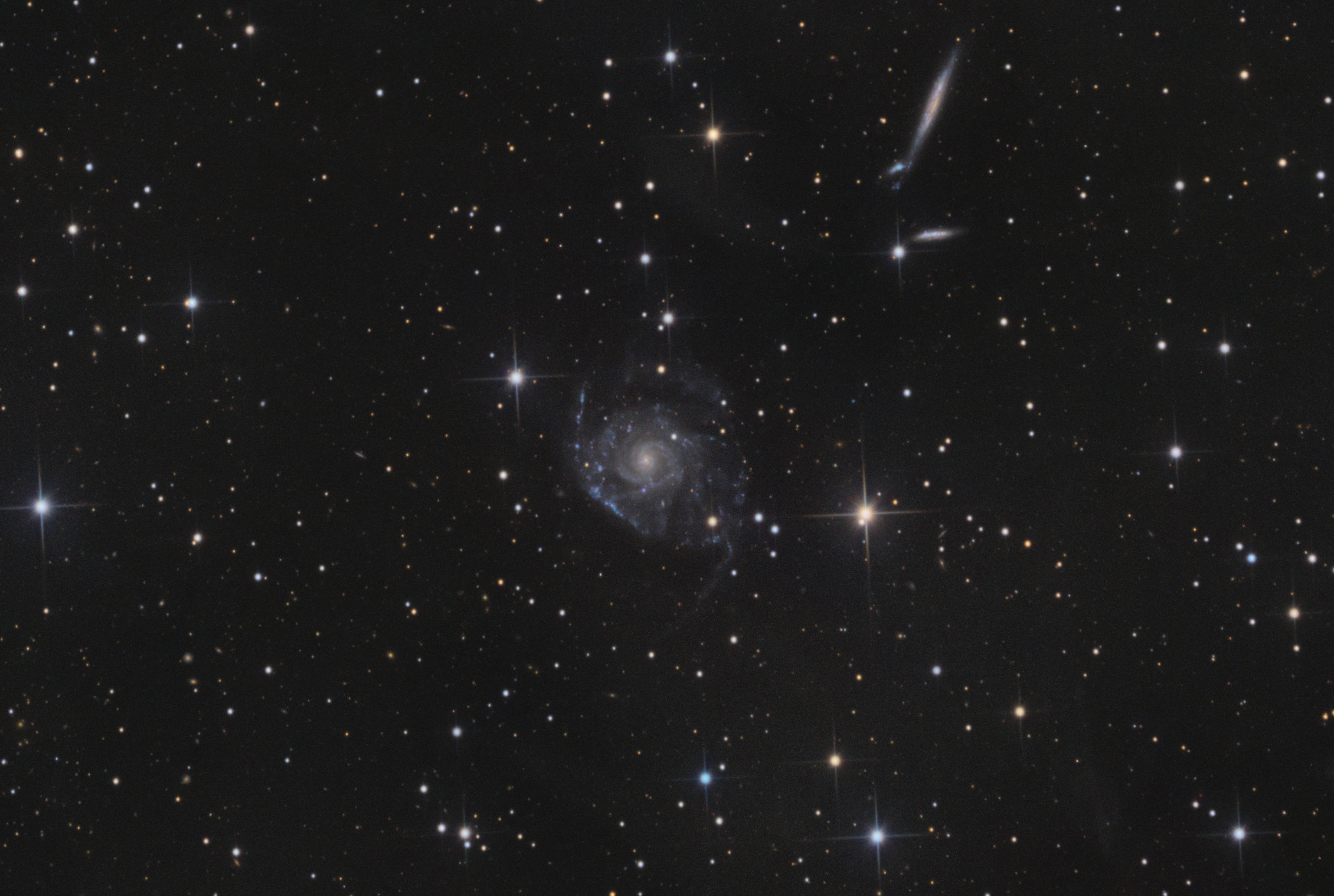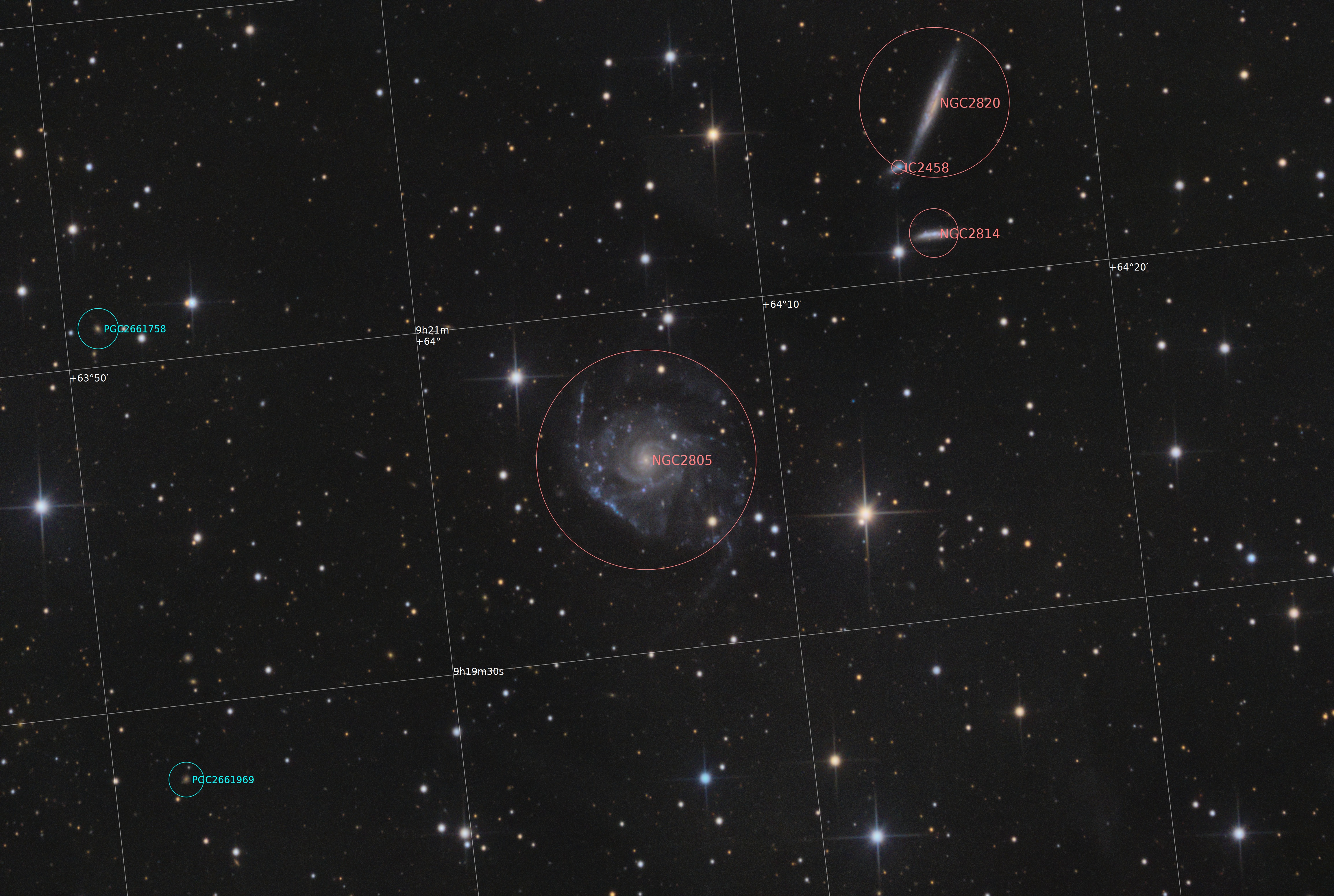
Holmberg 124 is a set of four interacting galaxies that can be found in Ursa Major. Centered in this image is NGC2805. The longest edge-on galaxy is NGC2820 and two smaller nearby galaxies are NGC2814 and IC2458.
NGC2805 is very active with lots of star-forming regions that can be seen particularly throughout the left arm. This activity seems to be recently encouraged by the interactions with the other galaxies in this group.
Faint “whisps” of gases and dust are also visible in the image. This “flux nebula” sits outside of our own Milky Way galaxy but close enough that they are illuminated by the light coming from our galaxy. Sprinkled across this view are also many smaller and more distant galaxy groups.

Follow Me on Instagram | Astrobin
Equipment:
Orion 8in F4.9 1000mm Newtonian Reflector
- Flocked / Primary mirror replaced due to turned-down-edge
Skywatcher F4 Aplanatic Coma Corrector
Astrodon E Series L, R, G, B broadband filters
Celestron CGEM Mount
Self tuned / hacks to get guiding stable include:
Intentional offset polar alignment so dec always pulses in one direction
Balance “west” heavy (rather than the recommended east) so that the ota “falls” onto the gear teeth rather than get “lifted”
Factory Reset hand-controller daily (to prevent cgem from being possessed and forgetting where the meridian is on subsequent night)
Dither in RA only
8in f4.9 Orion Optical Tube Assembly - 1000mm
ASI183mm Pro cooled to -15C
ZWO OAG + ZWO EFW
Acquisition: Data was acquired across nine different nights from December 2019 to April 2020 from my backyard (Bortle 4 on the Light Pollution scale)
| Filter | Exposures | Exposure | ExposureTime |
|---|---|---|---|
| L | 205 | 240 s | 13:40:00 |
| L | 44 | 120 s | 01:28:00 |
| R | 53 | 240 s | 03:32:00 |
| G | 52 | 240 s | 03:28:00 |
| B | 51 | 240 s | 03:24:00 |
All pre-processing and post-processing was done in PixInsight. Full details below.
The resulting image is a combination of the following steps:
Inspected all subs for bad images with Blink, discarding subs containing clouds
Calibrated all subs with their corresponding master flat and master dark
Used subframe selector to weight all images based on the following weighting
1 |
|
- Selected the best sub from subframe and blink to use as a reference frame for aligning and integration
Breakdown of approved subs after Blink/Subframe Selector:
| Filter | Exposures | Exposure | ExposureTime |
|---|---|---|---|
| L | 181 | 240 s | 12:04:00 |
| L | 37 | 120 s | 01:14:00 |
| R | 47 | 240 s | 03:08:00 |
| B | 47 | 240 s | 03:08:00 |
| G | 45 | 240 s | 03:00:00 |
All subs of each filter were aligned to the same reference frame using the Star Alignment process
Integrated all Red frames together, Blue frames together and Green frames together and Luminance frames together to create masters for each color. These masters are available in the Public-Data section of my site.
Cropped the stacking edges of the integrated masters
[RGB Processing]
Channel combination to combine the integrated Red, Green and Blue frames
Dynamic Background Extraction
Background Neutralization using 3 small preview windows aggregated as a background reference
Image Solver |> Photometric Color Calibration
Saturated star cores were repaired using the HSV Repaired Separation script and recombined using HSV with Channel Combination
RGBWorking Space to 1,1,1
Noise Reduction was done using TGV Denoise with a low contrast mask and an autostretched local support, SCNR to remove the green overcast and MMT with a very protective luminance mask as documented by Jon Rista An additional round of DBE was used to remove newly discovered color gradients through the noise reduction process.
An initial stretched using Arcsinh Stretch followed by Masked Stretch
Additional noise reduction using MMT, ACDNR was applied
A final histogram curve and a masked C-Curve was applied to push the color data.
The RGB image was placed asside for Luminance Processing Next
[Luminance Processing]
Dynamic Background Extraction
Independently produce a noise reduced image and a sharpened image
Noise Reduction was done using TGV Denoise with a low contrast mask and an autostretched local support and MMT with a very protective luminance mask
Deconvolution was done on a separate copy of the luminance with
No deringing
wavelet regularization with 5 layers and strong but reducing amounts/thresholds
A combination of starmask and clone stamp was used to produce a series of star masks that together covered all ringing artifacts produced by deconvolution
The noise reduced copy and the sharpened copy were combined using a luminance-based mask where the high-signal areas were filled in from the deconvolution copy and the low-signal areas were filled in from the noise reduction copy
Decon*CombineMask+NR*~CombineMaskThe resulting luminance was stretched using Masked Stretch, no clipping, and the same background preview windows aggregated. The tail was brought in using histogram transformation, and the stretch was repeated.
[Combination and Final Adjustments]
The Luminance and the RGB Image was brought together using the Channel Combination Tool in LAB mode applying the processed/stretched luminance to the processed/stretched RGB images
Two rounds of Local Histogram Equalization (512 and 256) were applied to bring out the faint IFN regions using a star mask that protected the largest of stars. The mask was not quite sufficient and produced darker patches around the brighter stars, and so afterwards applied a luminance curve with the mask inverted to correct.
Final round of chrominance noise reduction on the stars slight S-Curve to increase the overall contrast. The star cores of the brighter stars were cleaned up with a small amount of convolution and a mask.
Per some Constructive Criticism I opted to raise the black point a bit on a newly extracted luminance and re-applied using the LRGB combination tool. Enabling a single wavelet layer of chrominance smoothing on combination. This does seem to bring out the IFN a bit more especially on my mobile device. Thank’s for the tip Bogdan Borz!
An ICC Profile was applied to enable Black Point Compensation
Constructive criticism is welcome. Let me know what you think! How can I improve?